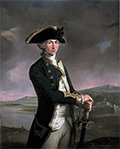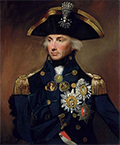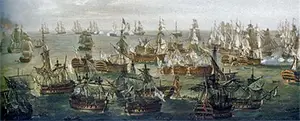Horatio Nelson: Naval Hero
Horatio Nelson was one of the most well-known sea captains in the history of Great Britain and the United Kingdom. He found his greatest success at the Battle of Trafalgar, in 1805, a battle that also cost him his life. He was born on Sept. 29, 1758, in Burnham Thorpe, in Norfolk. He attended Paston Grammar School, in North Walsham, and King Edward VI's Grammar School, in Norwich. 
He joined the Royal Navy when he was 12, serving under his uncle, Captain Maurice Suckling aboard the Rainsonnable. Not long into his naval career, he discovered that suffered from seasickness; he never shook the affliction. He crisscrossed the Atlantic and also sailed around the Iberian Peninsula to Gibraltar. and achieved the rank of Captain by the time he was 20. His first command was of the Hinchinbrook. Among his early assignments was transporting Prince William (who in 1820 became King William IV) to the West Indies. He also fought against Spanish settlements in 1779 in Central America, as part of the American Revolutionary War. He suffered from an unknown illness, which many scholars think was malaria, and convalesced in Britain. He married Frances Nesbit in 1787. She had a son, Josiah, who was then 5 and whom Nelson eventually took to sea with him. 
In 1793, Nelson gained command of the ship Agamemnon. He saw combat in the Mediterranean theatre during the War of the First Coalition. He helped the British fleet capture the island of Corscia from France. During the siege at Calvi, a shower of gravel struck him in the face, blinding him in his right eye. He sustained further injury at the Battle of Santa Cruz de Tenerife, in 1797, losing his right arm while leading a landing party assault on the town. He had earlier gained fame leading another landing party, this one from one ship to another, as he captured two ships during the Battle of Cape St. Vincent, in February 1797. Earlier in that same battle, he had held off attacks from seven different Spanish ships, many firing on his ship at the same time. He won decisively at the Battle of the Nile, in 1798. Nelson and his fleet decimated the French fleet, ending the French leader Napoleon Bonaparte's campaign to disrupt Britain's trade route to India. It was after this battle that Nelson went to Naples on assignment. There, he met Lady Emma Hamilton, whose husband was the British ambassador to Naples, Sir William Hamilton. Nelson and Mrs. Hamilton remained close the rest of their lives. Nelson was a man of strong opinions and was known to ignore or change orders as he saw fit. In one such instance, near the end of the War of the Second Coalition, he carried out an attack on the Danish fleet after first claiming that he didn't see the order to retreat. (The second-in-command, he had looked to the flagship for orders but with his blinded eye.) Nelson was also known for his penchant for employing unorthodox strategy, and it more than once resulted in spectacular victory. This was no more the case than at the Battle of Trafalgar, on Oct. 21, 1805. For a battle plan, Nelson abandoned the traditional naval line of attack and directed his ships to divide the enemy force into three, attacking head-on at a very fast speed. This unorthodox approach allowed the U.K. ships to minimize the time that the Franco-Spanish ships under Admiral Pierre de Villeneuve would have to fire on their attackers. Nelson knew that his forces were experienced and well trained and that the reverse was true for the Franco-Spanish forces. Still, Villeneuve's ships had more men at his disposal–25,000 to 17,000–and plenty of firepower. Nelson and Villeneuve had opposed each other twice before. Both were respective seconds-in-command at the Battle of the NIle. And, a few months before their encounter near Trafalgar, Villeneuve had been the leader of a fleet of French and Spanish ships that had broken through the U.K. blockade and sailed across the Atlantic Ocean, in an attempt to divert U.K. ships from blocking the English Channel. The feint was part of an overall U.K. invasion plan by Bonaparte and France. The plan called for two fleets to break through, but only Villeneuve's managed the feat. After waiting at the rendezvous point for what he considered a sufficient amount of time, Villenevue ordered a return to Europe. As it turned out, Nelson and a force of U.K. ships was shadowing him. 
The two fleets engaged in battle on October 21, about 21 miles to the northwest of Cape Trafalgar. As planned, the U.K. ships formed two columns and struck at the heart of the enemy ships. Nelson observed the scene and issued orders from his flagship, Victory, while Villeneuve, from his flagship, Bucentaure did the same. The fighting was fierce and went on for five hours. Victory was so successful at engaging the French and Spanish ships that it got close enough to the French ships Redoutable to be boarded. It was then that a French sniper felled Nelson, the shot piercing the admiral's shoulder and chest. Another of Nelson's ships, Temeraire, entered the fray and forced Redoutable to retreat and, not long afterward, surrender. Nelson's fleet sunk or captured 22 of Villeneuve's ships (including Bucentaure) and lost none itself. Casualties on Nelson's side numbered 1,500; the 458 dead included Nelson himself, who died not long before the battle ended. French and Spanish losses were much higher: 4,700 dead, 2,500 injured, and several thousand captured. Nelson's last words were, "Now I am satisfied. Thank God, I have done my duty." His sailors preserved his body in brandy and took it back to the U.K. He was given a state funeral.  |
|
Social Studies for Kids
copyright 2002–2025
David White




